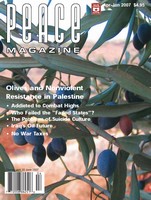
Peace Magazine Apr-Jun 2007, page 30. Some rights reserved.
Search for other articles by Martha Goodings here
Toronto: Between the Lines, 2006
Most Canadian activists recognize Ursula Franklin's name. She is one of our foremost female scientists and a lifelong peace activist. Born in Munich, she trained in experimental physics, specializing in metals research, and emigrated to Canada in 1948. In 1984 she became the first woman to be named University Professor at the University of Toronto. In 1989 she delivered the Massey Lectures.She is a Companion of the Order of Canada. Everyone familiar with her work will be glad to have so many pieces collected in one book.
You will want to own it so you can keep refreshing your memory of its wonderful analogies and memorable phrases. For example, she reminds us that, since peace is indivisible, it will be there not only for those we love but also for "all the creeps we are trying to avoid."
In the introduction to part two, which deals with technology, she insists that modern technologies require nothing less than "a rethinking of the concept of justice, as well as the notions of individual access to it." She sees the practice of pacifism as the only map to a just, peaceful, and more equal world.
Pacifism, as Michelle Swenarchuk states in helpful introduction to the book "tends to be dismissed as naïve and unrealistic, or disparaged as connoting appeasement or passivity in the face of force" For Ursula, this is not what the word means. For her, as for other members of the Religious Society of Friends, (Quakers), pacifism is not a prescription for "passive-ism". Rather it is an active and vigorous approach to confronting all aspects of life, including its horrors. It means living adventurously, using an alternative map.
One difficulty I have with the book is semantic. It seems to me that any term causing as much confusion as the term pacifism, which always needs to be explained and then redefined as differing from what it is generally thought to mean, is unhelpful in getting us where we have to go. Energetic pacifism seems to me almost as much an oxymoron as military intelligence. This isn't trivial. If we are to get large numbers of people onto an alternative path, they need to be clear which one they are following.
I find many people can relate much more enthusiastically to the concept of nonviolence, which connotes activity, and a vigorous alternative to force. And activity is certainly needed. As Ursula points out, "At the moment, we know nothing about the economy of peace: we do not know which of our technologies can be used to maintain a society of peace... [and our] ideas of the social structures of peace are as yet undeveloped..."
So what should we do? Ursula makes the following suggestion: "Within the framework of our search for the structures of peace, we must document those peaceful situations around us that do work....We should try and learn why they work, what it is that makes them peaceful and effective, and how we can extend these processes--on what scale and under what conditions of time and place."
This is a task we can all do. Let's be inspired by the book, and get on with it.
Reviewed by Martha Goodings, a Toronto activist.

Peace Magazine Apr-Jun 2007, page 30. Some rights reserved.
Search for other articles by Martha Goodings here